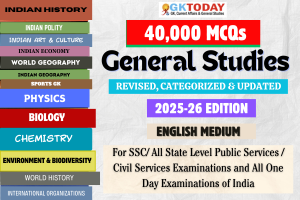41. Which countries are connected through the Karakoram Highway?
[A] India-Pakistan
[B] India-Nepal
[C] China-Pakistan
[D] India-Myanmar
Show Answer
Correct Answer: C [China-Pakistan]
Notes:
The Karakoram Highway connects China-Pakistan. The Karakorum Highway connects China and Pakistan across the Karakoram mountain range, through the Khunjerab Pass, at an elevation of 4,693 metres (15,397 ft) above the sea level. The road is one of the scariest and hair raising jeep trip in the world.
42. What is the maximum capacity of a Micro Hydropower project?
[A] 50KW
[B] 75KW
[C] 100KW
[D] 150KW
Show Answer
Correct Answer: C [100KW]
Notes:
The Hydropower plants are classified into 4 types- Micro(upto 100 KW), Mini(101KW to 2MW), Small(2 MW to 25 MW), and Mega(500MW).
43. If the price of a substandard item falls, what will be its demand?
[A] rises
[B] falls
[C] remains constant
[D] can be any of the above
Show Answer
Correct Answer: B [falls]
Notes:
Some items are known as substandard goods. With substandard goods, there is an inverse relationship between the actual income and the demand for the commodity under consideration. If real income rises, the demand for the inferior good will fall. If real income falls, the demand for the inferior product will increase. Example: bus travel, as people become richer, they are more likely to buy themselves a car or use a taxi, rather than relying on a more inferior bus, so demand for bus travel falls as real income rises .
44. When the demand for a commodity increases with increase in income, what is such a good called?
[A] Superior good
[B] Giffin good
[C] Inferior good
[D] Normal good
Show Answer
Correct Answer: C [Inferior good]
Notes:
In McConnell’s words, demand for the factors of production is a derived demand derived from the finished goods and services that resources help in production. Whereas demand for a commodity is direct demand, demand for factors is derived demand. It is based on the productivity of the factors.
45. Poverty in India is measured by any one of the following criteria?
[A] intake of the calories
[B] education level of the family
[C] number of rooms of the residence
[D] number of family members
Show Answer
Correct Answer: A [intake of the calories]
Notes:
Poverty in India has historically been defined and estimated using the standard of living. In the data, the poverty criterion was fixed based on the recommendations of the Alagh Committee of 1979 with reference to the daily intake of 2400 calories in rural areas and 2100 calories in urban areas. In the Rangarajan Committee estimate, the energy requirement has been determined. 2,155 kcal per person per day in rural areas and 2,090 kcal per person per day in urban areas.
46. In inflationary conditions, which of the following statements is false for a country?
[A] Profit rises faster than wages
[B] Value of money falls
[C] Cost of living rises
[D] Country’s exports become more competitive
Show Answer
Correct Answer: D [Country’s exports become more competitive]
Notes:
The rate at which the general level of prices of goods and services rises and subsequently purchasing power falls is called inflation. It can be seen through reduced export orders, lower profits and fewer jobs, and also in a worsening of a country’s trade balance. A fall in exports can trigger negative multiplier and accelerator effects on national income and employment. However, in the long run, it leads to depreciation of currency that restores the competitiveness of exports.
47. Which is not a measure taken by the government to check inflation?
[A] Increase in consumption
[B] Increase in production
[C] Reduction in Deficit financing
[D] Taxation measures
Show Answer
Correct Answer: A [Increase in consumption]
Notes:
One of the important fiscal measures taken by governments to check inflation is to cut down on personal consumption expenditure. This is done by raising personal, corporate and commodity tax rates and even by imposing new taxes. To curb inflation, the government can also reduce unnecessary expenditure on non-development activities.
48. Which is an indirect tax?
[A] Capital Gains Tax
[B] Excise Duty
[C] Wealth Tax
[D] Estate Duty
Show Answer
Correct Answer: B [Excise Duty]
Notes:
Some examples of indirect taxes include value added tax, excise duty, sales tax, stamp duty and custom duty levied on imports. These are taxes levied by the state on expenditure and consumption, but not on property or income.
49. Money in India consists of ____.
[A] Paper currency
[B] Current deposits
[C] Metallic coins
[D] All options are correct
Show Answer
Correct Answer: D [All options are correct]
Notes:
For theoretical purposes money is defined as any asset which performs the functions of money. Money in India includes all coins and paper money issued by the government and the banks. It refers to the total amount of coins and paper currency that has ever been issued by the Reserve Bank of India.
50. What was the main objective of the fifth five year plan?
[A] Removal of poverty and achievement of self-reliance
[B] Faster, more inclusive and sustainable growth
[C] Inclusive growth
[D] None of these
Show Answer
Correct Answer: A [Removal of poverty and achievement of self-reliance]
Notes:
The Fifth Plan (1974-1978) had the objectives of increasing the employment level, reducing poverty, and attaining self-reliance. The twin objectives of poverty eradication (Garibi Hatao) and attainment of self reliance were its highlights. It included a national program for minimum needs including elementary education, safe drinking water, health care, etc.
 These questions are part of GKToday's 40,000+ GK Questions Course in GKToday Android Application which provides more than 40K questions with explanations suitable for all Competitive Exams of India.
These questions are part of GKToday's 40,000+ GK Questions Course in GKToday Android Application which provides more than 40K questions with explanations suitable for all Competitive Exams of India.
